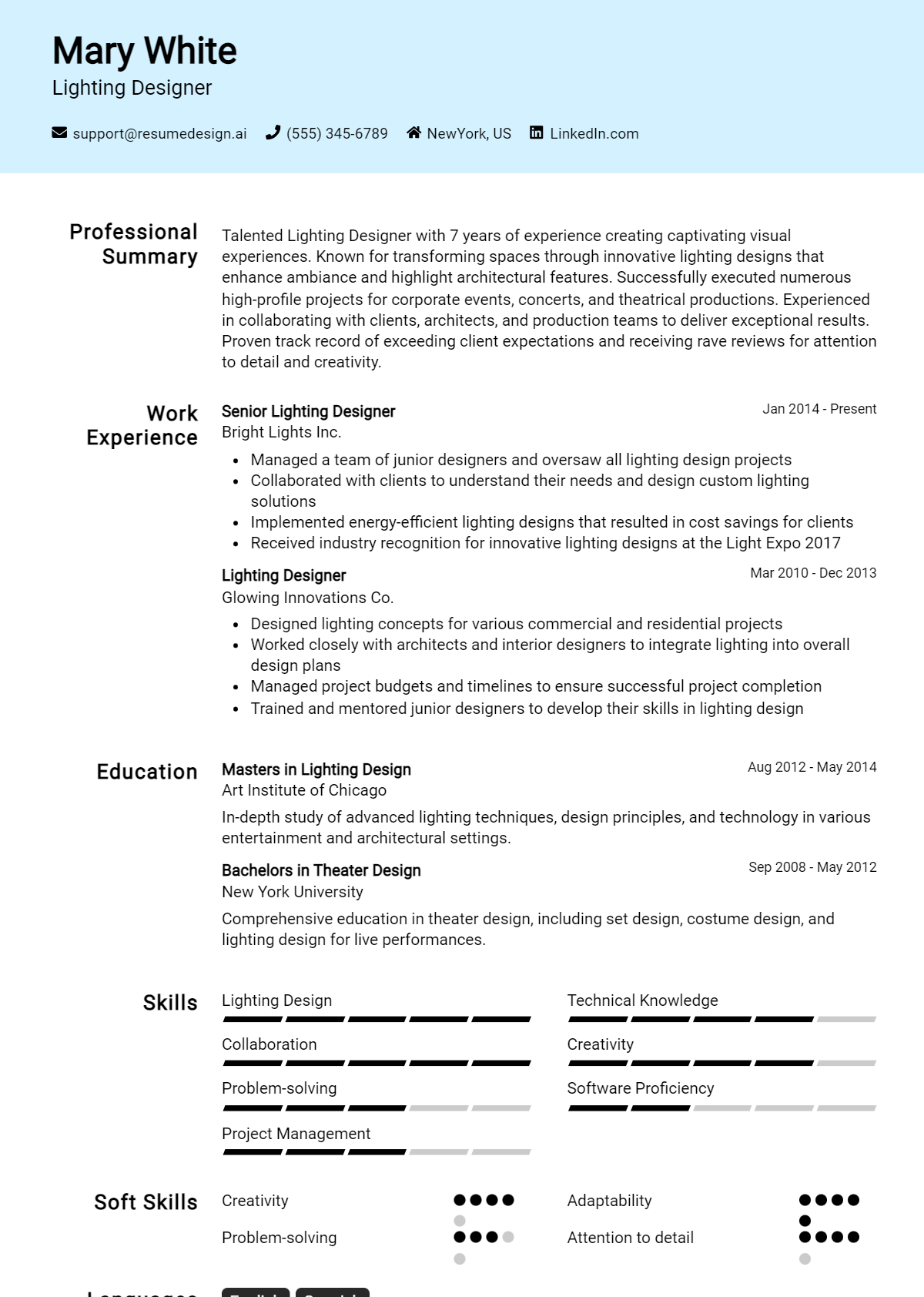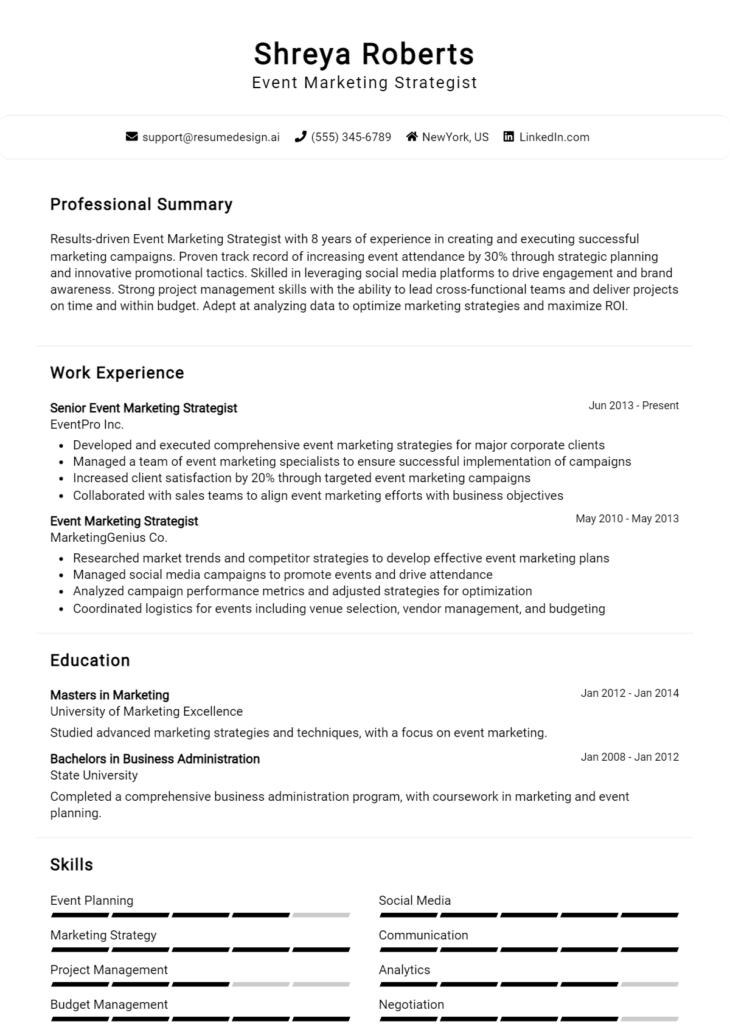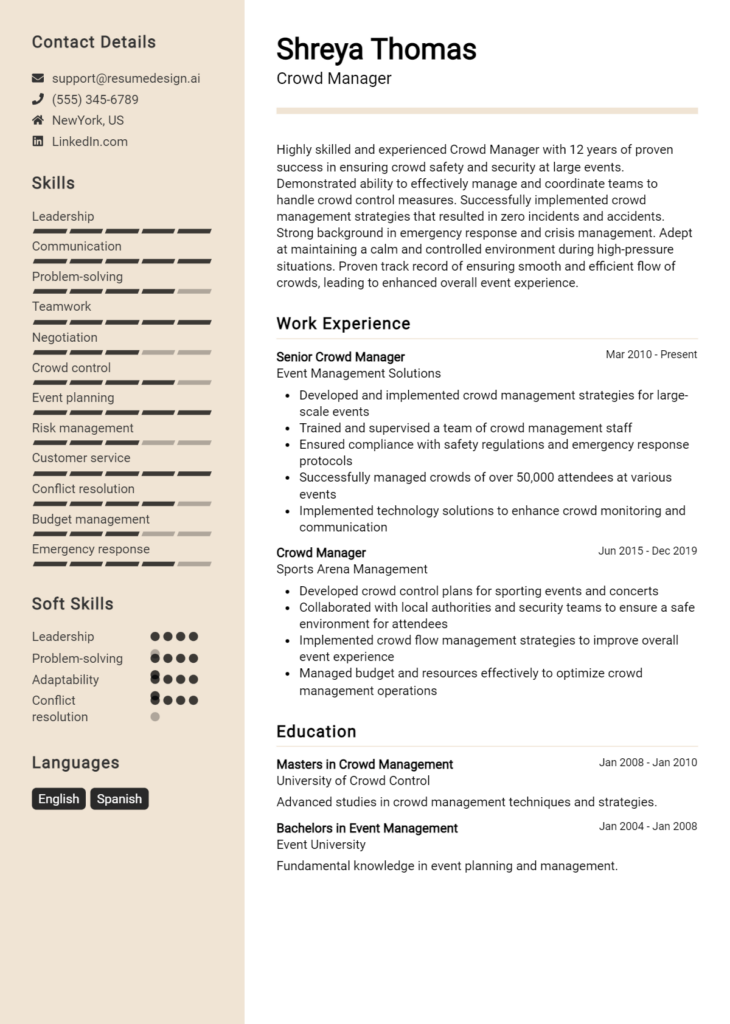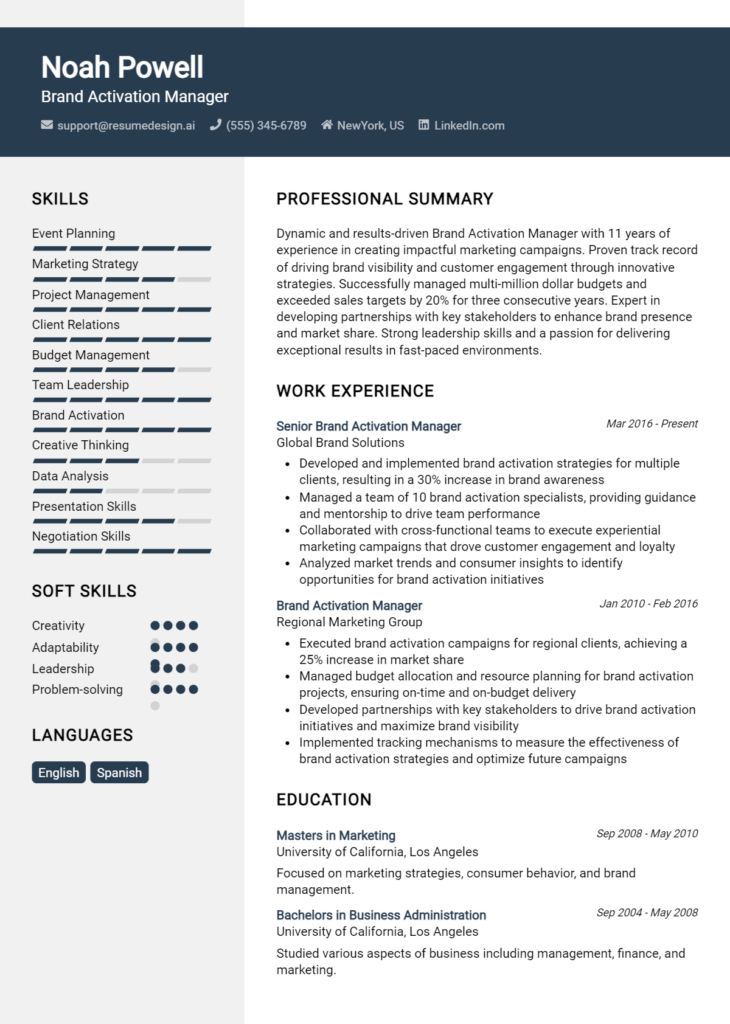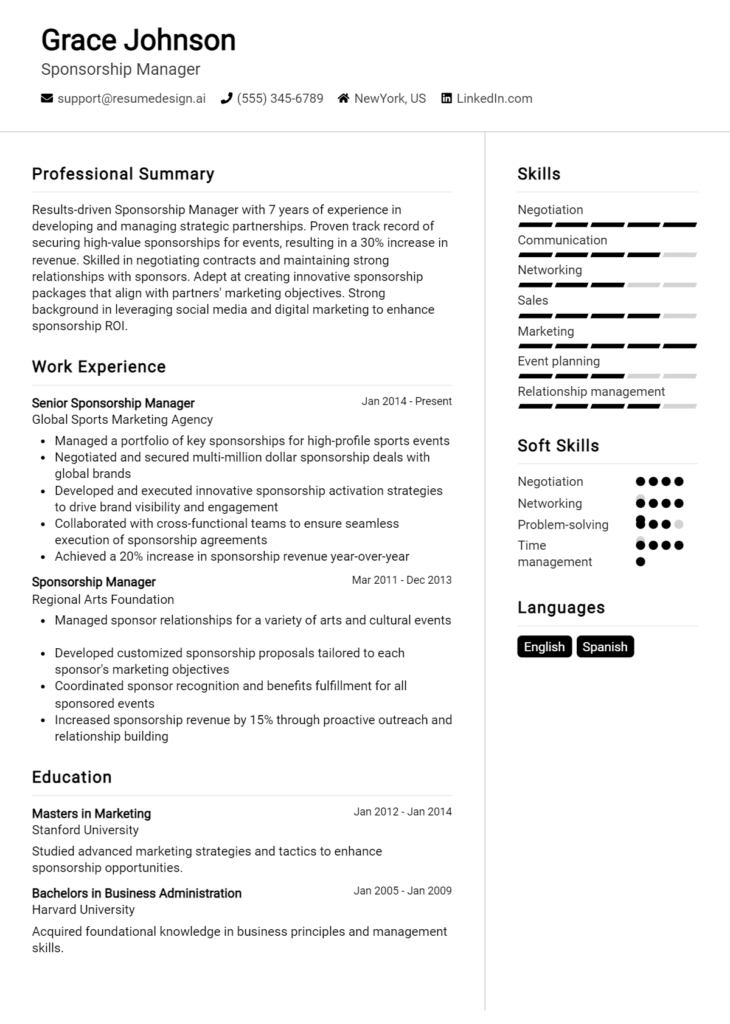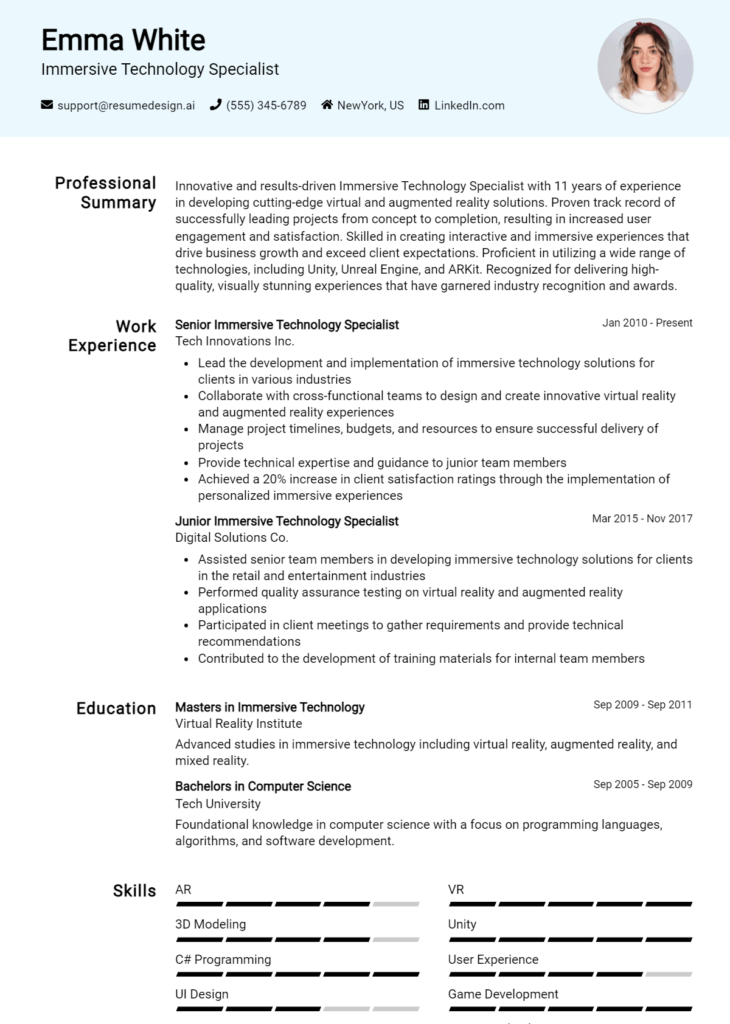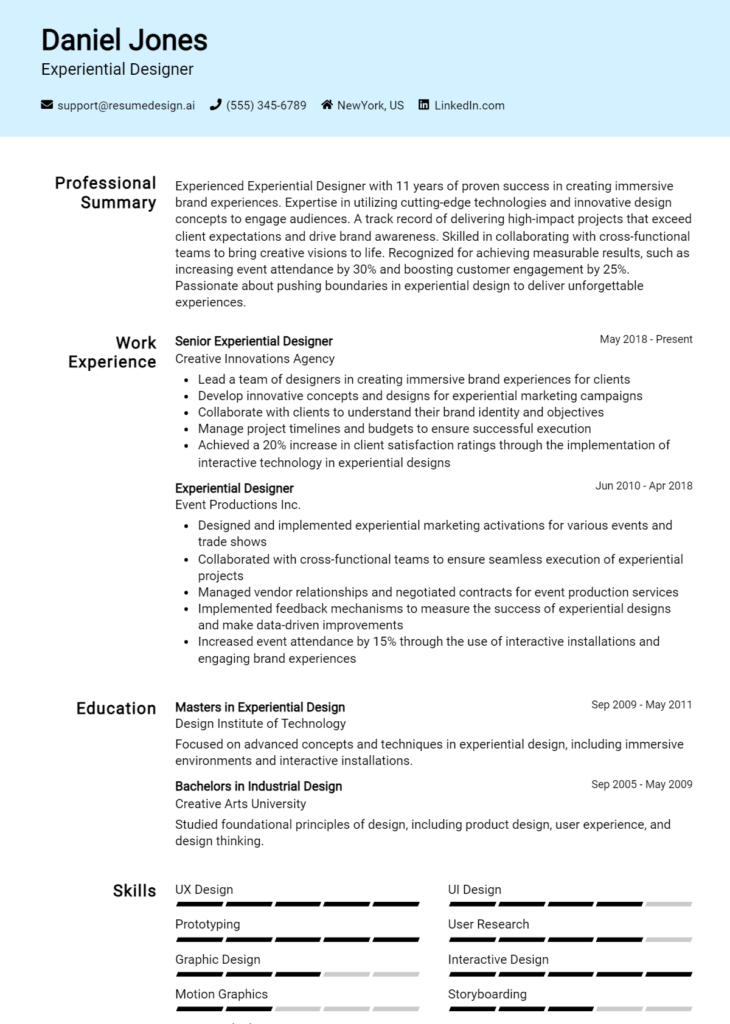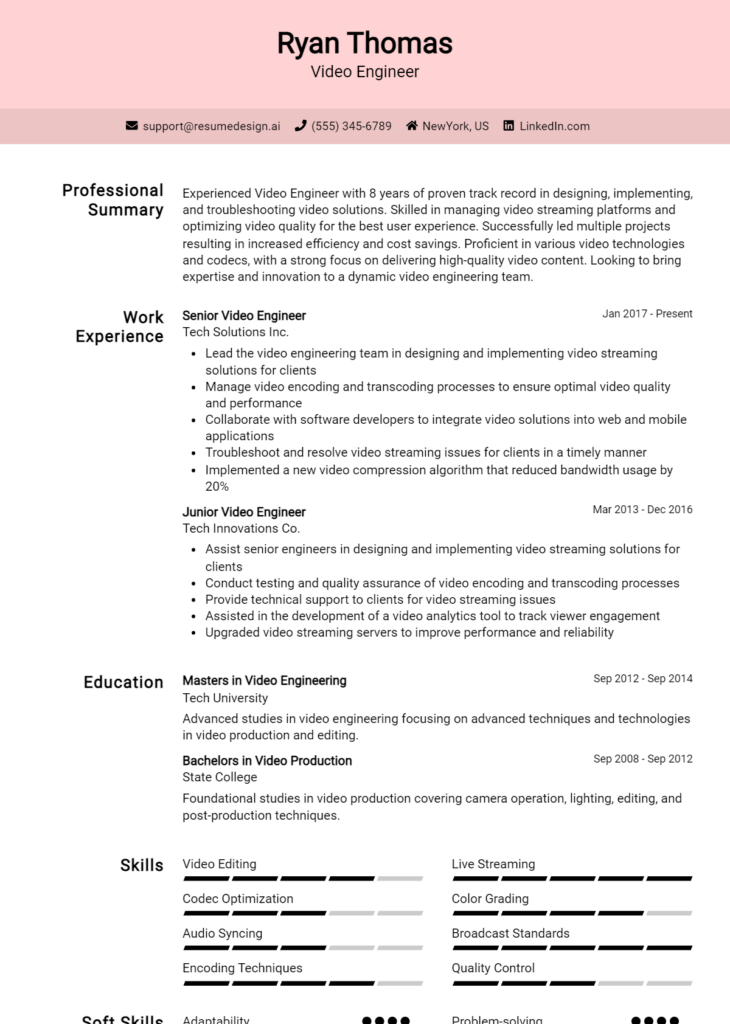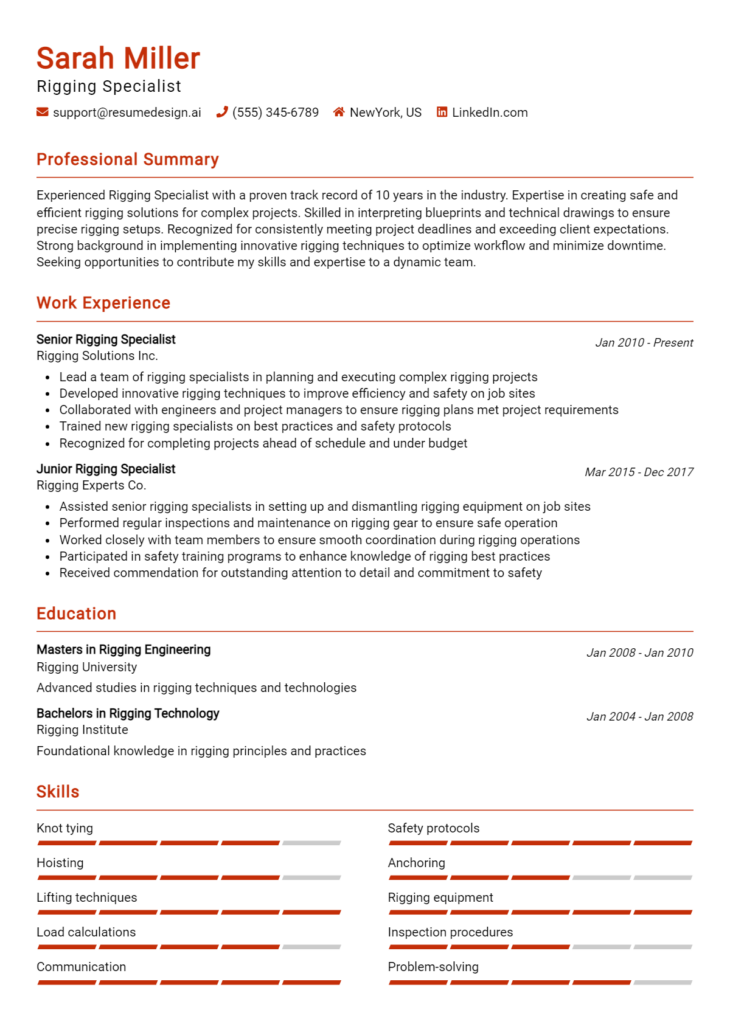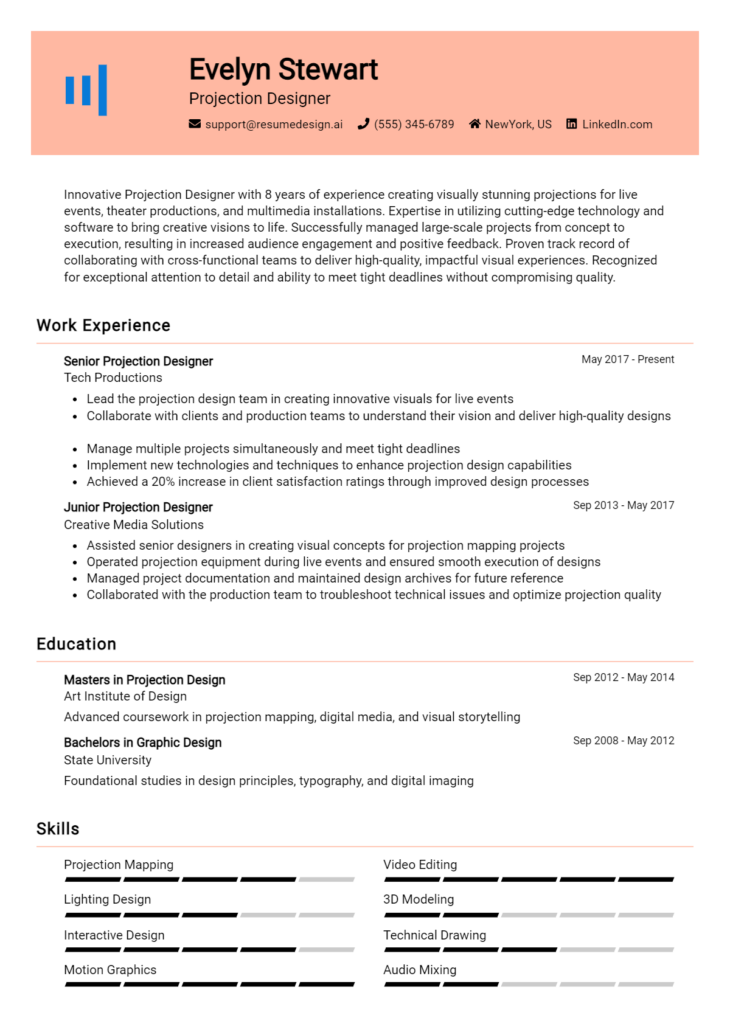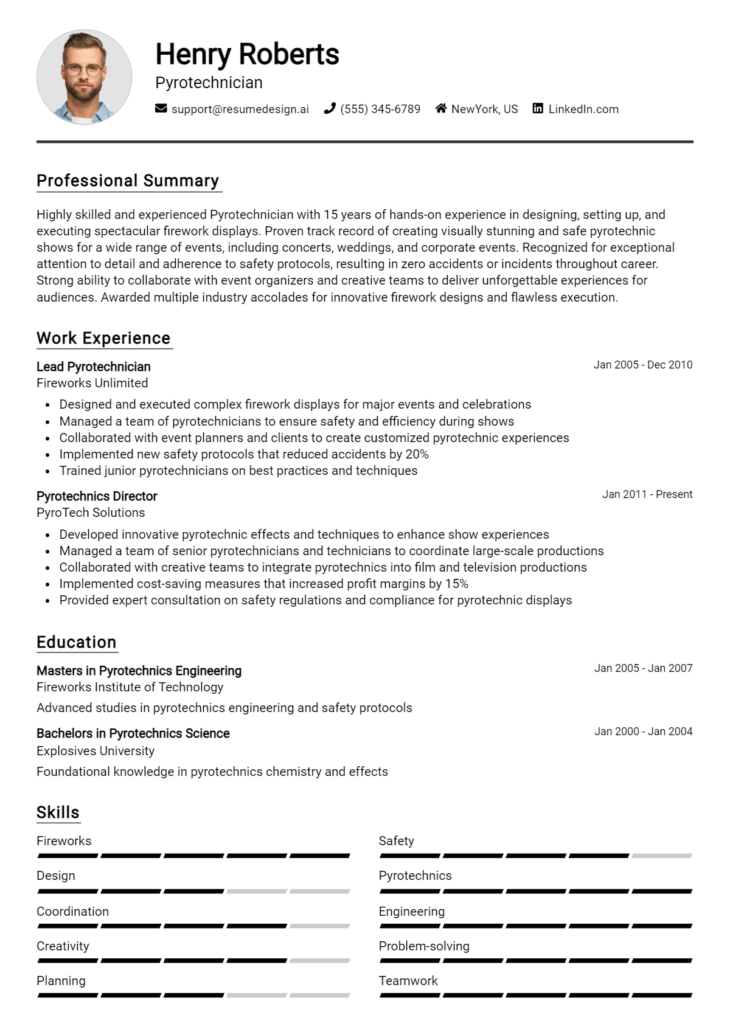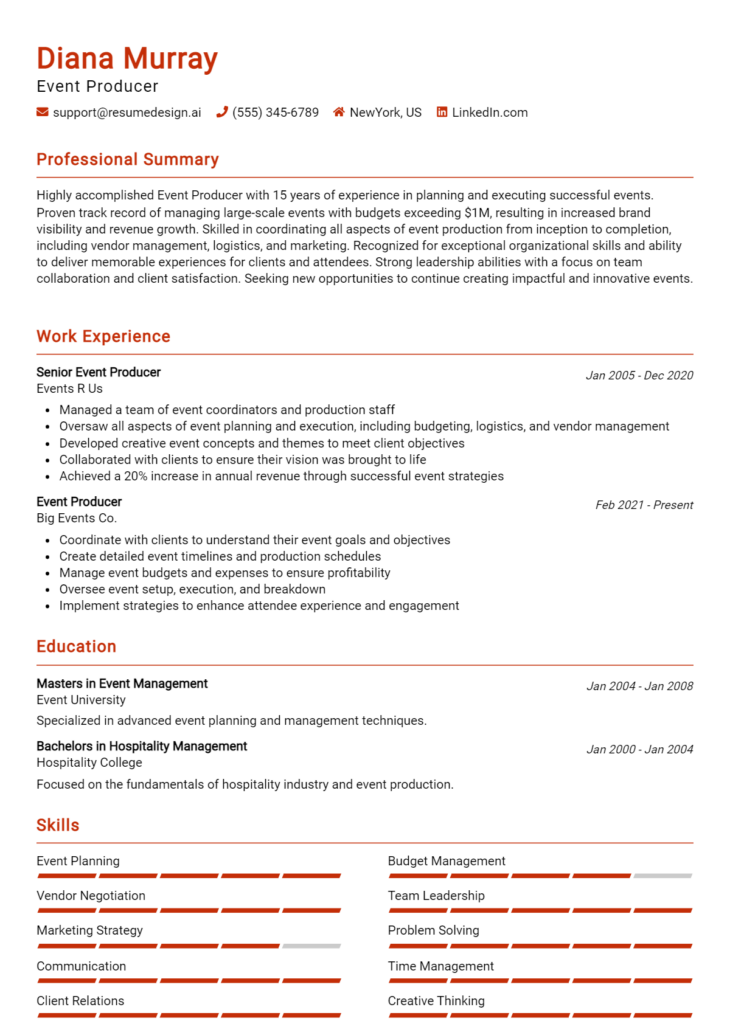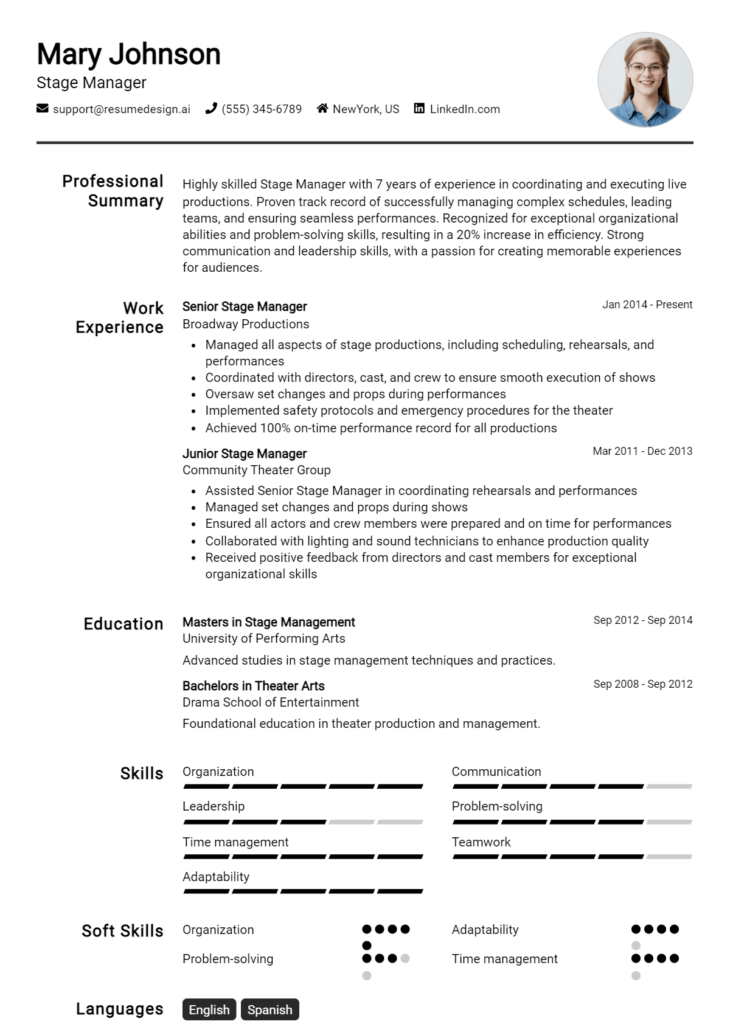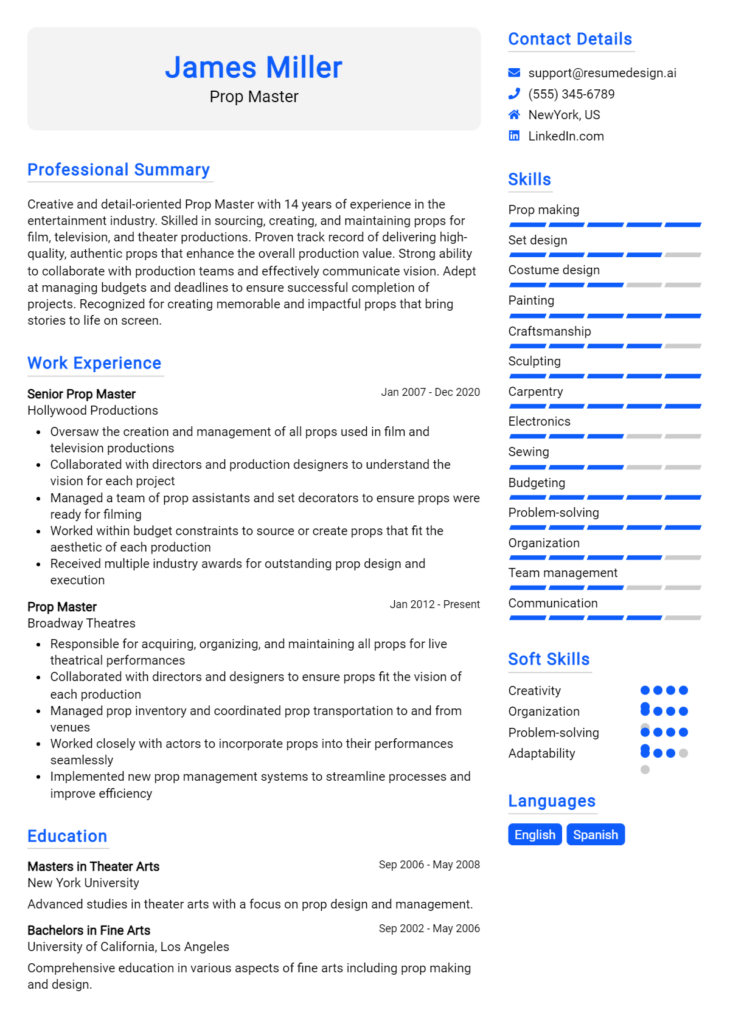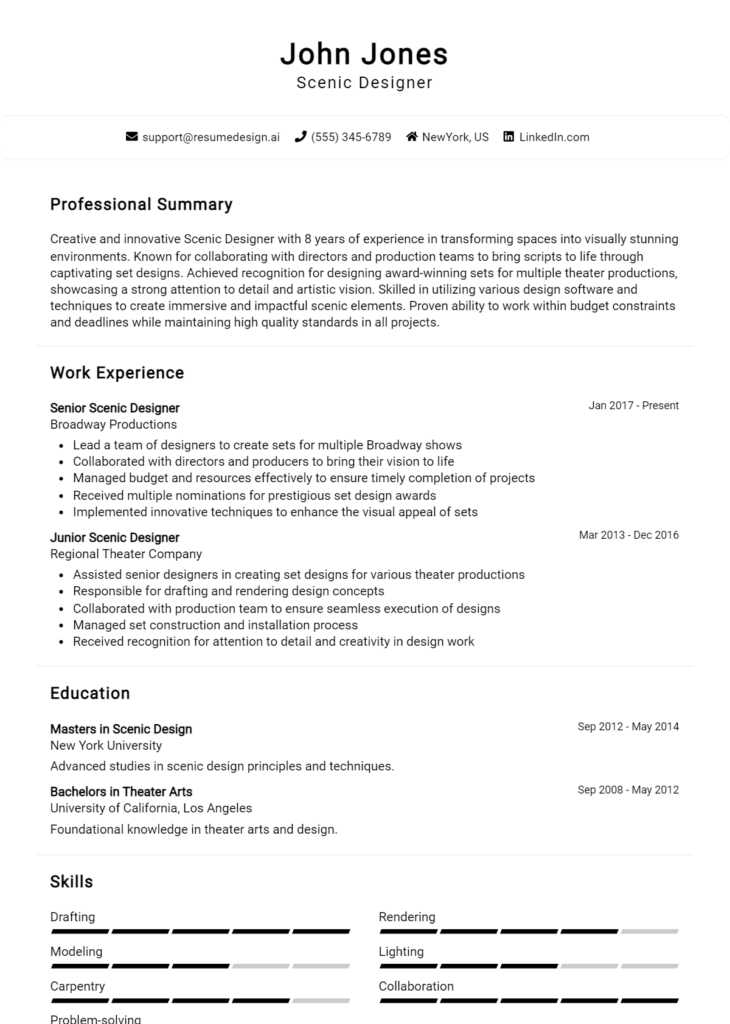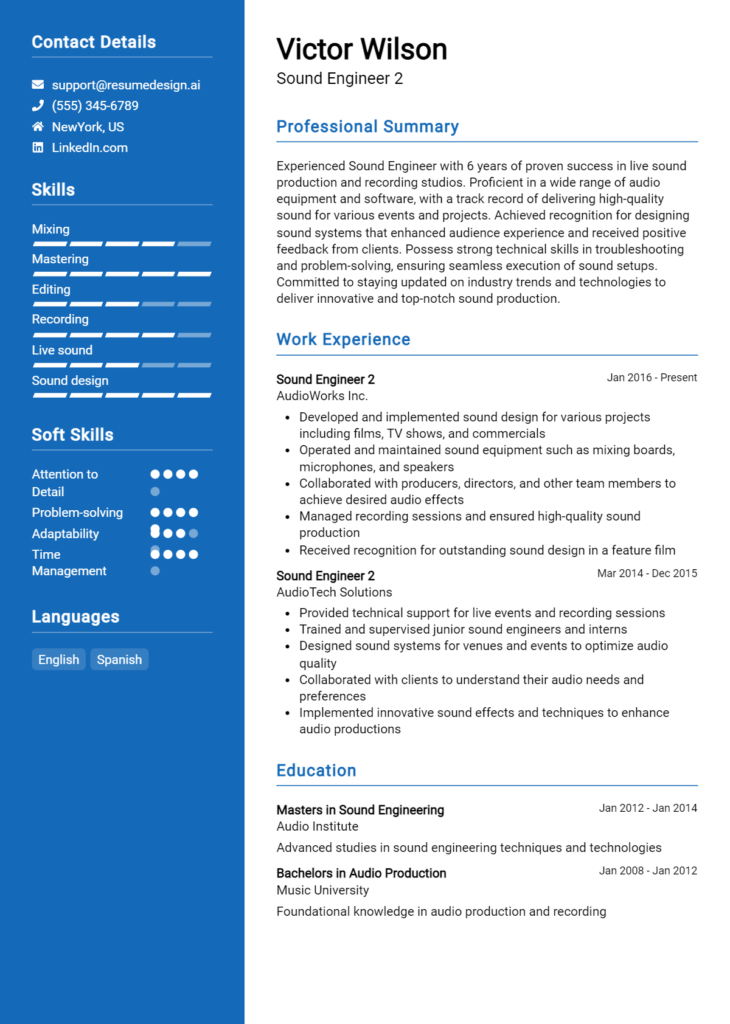Lighting Designer Core Responsibilities
A Lighting Designer is crucial in creating the visual atmosphere of a space, collaborating with various departments such as production, architecture, and event planning. Their core responsibilities include designing lighting plans, selecting appropriate fixtures, and ensuring that lighting enhances the overall aesthetic while meeting safety regulations. Essential skills include technical proficiency, operational planning, and problem-solving abilities. These competencies contribute significantly to the organization’s goals by enhancing the audience's experience, and a well-structured resume can effectively highlight these qualifications.
Common Responsibilities Listed on Lighting Designer Resume
- Develop and present innovative lighting concepts for projects.
- Collaborate with directors, set designers, and other team members.
- Select and specify lighting equipment and materials.
- Design lighting layouts and installation plans.
- Conduct site visits to assess lighting needs and challenges.
- Manage budgets and timelines for lighting projects.
- Implement energy-efficient lighting solutions.
- Oversee installation and testing of lighting systems.
- Ensure compliance with safety and industry standards.
- Adjust lighting designs based on feedback during rehearsals.
- Document and maintain records of lighting designs and specifications.
- Stay updated on trends and technologies in lighting design.
High-Level Resume Tips for Lighting Designer Professionals
In the competitive world of lighting design, a well-crafted resume is crucial for standing out among a pool of talented candidates. For Lighting Designer professionals, the resume serves as the first impression on potential employers, making it essential to effectively showcase not only technical skills but also past achievements that demonstrate creativity and impact. A resume that reflects a candidate's unique expertise and accomplishments can open doors to exciting opportunities. This guide will provide practical and actionable resume tips specifically tailored for Lighting Designer professionals, helping you to craft a document that highlights your qualifications and sets you apart from the competition.
Top Resume Tips for Lighting Designer Professionals
- Tailor your resume to each job description, emphasizing the skills and experiences that align with the specific requirements of the position.
- Showcase relevant experience by including projects you've worked on, detailing your role and the impact of your contributions.
- Quantify your achievements whenever possible, using metrics such as the number of successful projects, budget management, or audience engagement statistics.
- Highlight industry-specific skills, including software proficiency (e.g., AutoCAD, Vectorworks), technical knowledge, and design principles.
- Include a portfolio link that showcases your work, providing visual evidence of your design capabilities and aesthetic sense.
- Utilize a clean and professional layout, ensuring that your resume is visually appealing and easy to read, reflecting your design sensibility.
- Incorporate keywords from the job posting to pass through Applicant Tracking Systems (ATS) and to show that you understand the role.
- List relevant certifications or training programs that demonstrate your commitment to professional development in lighting design.
- Consider including a brief summary or objective statement that succinctly captures your career goals and what you bring to a potential employer.
By implementing these tips, Lighting Designer professionals can significantly enhance their resumes, increasing the likelihood of capturing the attention of hiring managers and landing a job in this dynamic field. A strong resume not only showcases your skills, but also tells the story of your professional journey, making it easier for potential employers to envision you as a valuable addition to their team.
Why Resume Headlines & Titles are Important for Lighting Designer
In the competitive field of lighting design, a well-crafted resume headline or title is essential for making a strong first impression on hiring managers. A powerful headline serves as a snapshot of a candidate's professional identity and key qualifications, immediately capturing attention and succinctly summarizing their expertise. It should be concise, relevant, and tailored specifically to the job being applied for, ensuring that it aligns with the expectations of potential employers. A compelling headline not only enhances the overall presentation of a resume but also sets the tone for the rest of the application, making it a crucial element in the job search process.
Best Practices for Crafting Resume Headlines for Lighting Designer
- Keep it concise: Aim for a one-sentence headline that encapsulates your core strengths.
- Make it role-specific: Use terminology and keywords that are relevant to the lighting design industry.
- Highlight key skills: Incorporate your most impressive skills that align with the job description.
- Include relevant experience: Mention years of experience or notable projects if applicable.
- Use action words: Start with strong action verbs that convey your contributions and impact.
- Be unique: Avoid cliché phrases; instead, create a headline that reflects your unique value proposition.
- Tailor for the job: Customize your headline for each application to match the specific requirements of the position.
- Maintain professionalism: Ensure your headline reflects a professional tone suitable for the industry.
Example Resume Headlines for Lighting Designer
Strong Resume Headlines
Innovative Lighting Designer with 10+ Years of Experience in Theatrical Productions
Award-Winning Lighting Designer Specializing in Sustainable Design Solutions
Creative Lighting Specialist with Proven Expertise in Architectural and Event Lighting
Weak Resume Headlines
Lighting Designer Looking for Opportunities
Experienced Professional in Lighting
The strong headlines are effective because they provide specific information about the candidate's experience and specialization, immediately conveying their value to potential employers. They utilize relevant keywords and highlight unique skills, making it easy for hiring managers to see what sets the candidate apart. In contrast, the weak headlines lack specificity and fail to capture interest, making them forgettable and less impactful. By avoiding vague language and focusing on concrete strengths, candidates can make a memorable impression that stands out in a crowded job market.
Writing an Exceptional Lighting Designer Resume Summary
A well-crafted resume summary is essential for a Lighting Designer, as it serves as the first impression for hiring managers. This brief yet powerful section quickly captures attention by highlighting key skills, relevant experience, and notable accomplishments tailored to the specific job in question. A strong summary not only emphasizes the candidate's qualifications but also sets the tone for the entire resume, making it critical to be concise and impactful, ensuring it aligns closely with the job description to resonate with potential employers.
Best Practices for Writing a Lighting Designer Resume Summary
- Quantify Achievements: Use numbers and statistics to demonstrate the impact of your work, such as the size of projects managed or budget savings achieved.
- Focus on Relevant Skills: Highlight specific lighting design skills that are pertinent to the job description, such as proficiency in CAD software or experience with various lighting techniques.
- Tailor the Summary: Customize your resume summary for each job application, ensuring it directly addresses the requirements and responsibilities of the position.
- Be Concise: Keep the summary brief—ideally 2-4 sentences—while still conveying your key qualifications and experiences.
- Highlight Industry Experience: Mention any notable projects or collaborations within the industry that showcase your expertise and knowledge as a Lighting Designer.
- Use Action Words: Start sentences with strong action verbs to convey your contributions and make the summary more dynamic.
- Showcase Creativity: As a Lighting Designer, emphasize your creative approach and ability to craft unique lighting solutions that enhance the overall aesthetic of a project.
- Maintain Professional Tone: Ensure the summary reflects a professional tone that aligns with the expectations of potential employers in the design field.
Example Lighting Designer Resume Summaries
Strong Resume Summaries
Dynamic Lighting Designer with over 8 years of experience creating innovative lighting solutions for theater and live events. Successfully managed lighting design for over 50 productions, resulting in a 20% increase in audience engagement and satisfaction ratings.
Detail-oriented Lighting Designer with a proven track record in residential and commercial projects, focusing on energy-efficient designs. Led a team that completed a large-scale commercial project under budget by 15%, enhancing client satisfaction through superior lighting aesthetics.
Creative Lighting Designer skilled in utilizing advanced CAD software and LED technology to create immersive environments. Recognized for excellence in design, winning the 2022 XYZ Lighting Award for the best set design in a theatrical production.
Weak Resume Summaries
Lighting Designer with experience in various projects. I have worked on many types of events and have a good understanding of lighting.
A creative individual interested in lighting design. Looking to apply skills in a new position and contribute to projects.
The strong resume summaries stand out because they incorporate quantifiable achievements, specific skills, and relevant experiences tailored to the Lighting Designer role. They provide concrete examples of success and highlight the candidate's unique contributions. In contrast, the weak summaries lack detail and specificity, failing to convey the candidate's qualifications or the impact of their work, making them less appealing to hiring managers.
Work Experience Section for Lighting Designer Resume
The work experience section of a Lighting Designer resume is critical for showcasing a candidate's technical skills and practical knowledge within the industry. This section serves as a platform to highlight not only the candidate's proficiency in lighting design but also their ability to manage teams and deliver high-quality projects on time and within budget. By quantifying achievements and aligning past experiences with industry standards, candidates can effectively demonstrate their value and readiness for the role. This focus on measurable outcomes and relevant competencies can set them apart in a competitive job market.
Best Practices for Lighting Designer Work Experience
- Highlight specific technical skills related to lighting design, such as software proficiency (e.g., AutoCAD, Vectorworks).
- Quantify achievements, such as the number of projects completed or increase in client satisfaction ratings.
- Include details about team management and collaboration, emphasizing any leadership roles held.
- Use industry-standard terminology to align your experience with the expectations of employers.
- Provide context for each role, detailing the scope and impact of your contributions.
- Tailor your experience to the job description, focusing on the most relevant roles.
- Showcase any awards or recognitions received for projects or design excellence.
- Include links to online portfolios or case studies where applicable.
Example Work Experiences for Lighting Designer
Strong Experiences
- Led a team of 5 designers in the execution of a high-profile event, resulting in a 30% increase in client satisfaction and repeat business.
- Designed and implemented a sustainable lighting plan for a commercial building, reducing energy consumption by 25% over three years.
- Coordinated with architects and contractors on over 20 large-scale projects, ensuring on-time delivery and adherence to budget constraints.
- Developed a new lighting technique that received an industry award, enhancing the aesthetic appeal of public spaces.
Weak Experiences
- Worked on various lighting projects without specifying any outcomes or responsibilities.
- Assisted in lighting design but did not detail specific contributions or skills used.
- Involved in team meetings but did not mention any leadership or decision-making roles.
- Responsible for lighting setups with no mention of project scale or impact.
The examples provided illustrate the difference between strong and weak experiences in a Lighting Designer's resume. Strong experiences clearly articulate measurable outcomes, specific technical skills, and collaborative efforts that showcase leadership and initiative. In contrast, weak experiences lack detail and context, making it difficult for potential employers to understand the candidate's value and contributions to past projects. By focusing on quantifiable results and clearly defined roles, candidates can present themselves as qualified and capable professionals in the lighting design field.
Education and Certifications Section for Lighting Designer Resume
The education and certifications section of a Lighting Designer resume is crucial as it showcases the candidate's academic background and relevant industry credentials. This section not only demonstrates formal training and expertise in lighting design principles but also highlights the candidate’s commitment to continuous learning and professional development. By including relevant coursework, specialized training, and notable certifications, applicants can significantly enhance their credibility and better align themselves with the specific requirements of the job role, thereby increasing their chances of standing out to potential employers.
Best Practices for Lighting Designer Education and Certifications
- Include only relevant degrees and certifications that pertain to lighting design or the broader field of design.
- List your most recent educational experiences first, following a reverse chronological order.
- Highlight industry-recognized certifications, such as those from the International Association of Lighting Designers (IALD) or the National Council on Qualifications for the Lighting Professions (NCQLP).
- Provide details about coursework that directly relates to lighting design, such as 'Lighting Technology' or 'Architectural Lighting Design.'
- Be specific about any specialized training or workshops attended, particularly those that are well-regarded in the industry.
- Avoid including irrelevant degrees or certifications that do not bolster your qualifications for the lighting design role.
- Consider mentioning ongoing education or professional development efforts to demonstrate your commitment to staying current in the field.
- Keep the formatting consistent and professional to enhance readability and presentation.
Example Education and Certifications for Lighting Designer
Strong Examples
- Bachelor of Fine Arts in Lighting Design, University of Arts, 2021
- Certified Lighting Designer (CLD), National Council on Qualifications for the Lighting Professions, 2022
- Coursework: Advanced Lighting Techniques, Sustainable Lighting Design, and Theatrical Lighting Systems
- Workshop: LED Lighting Innovations, IALD Annual Conference, 2023
Weak Examples
- Bachelor of Arts in English Literature, State University, 2015
- Certification in Basic Electrical Engineering, 2016
- Coursework: Introduction to Psychology
- Workshop: Basic Photography Techniques, 2020
The examples listed above are considered strong because they directly align with the qualifications and skills needed for a Lighting Designer role, showcasing relevant degrees, recognized certifications, and specialized training in lighting design. In contrast, the weak examples highlight irrelevant degrees and certifications that do not contribute to the candidate's expertise in lighting design, potentially undermining their application and perceived suitability for the role.
Top Skills & Keywords for Lighting Designer Resume
As a Lighting Designer, showcasing the right skills on your resume is crucial to standing out in a competitive job market. The combination of both hard and soft skills not only reflects your technical competency but also highlights your ability to collaborate, communicate, and innovate within the creative industry. Employers seek candidates who can expertly navigate the complexities of lighting design while also demonstrating a strong understanding of project management and teamwork. By emphasizing these skills, you can effectively convey your value and suitability for the role.
Top Hard & Soft Skills for Lighting Designer
Soft Skills
- Creativity
- Attention to Detail
- Communication Skills
- Team Collaboration
- Time Management
- Problem-Solving
- Adaptability
- Critical Thinking
- Client Relationship Management
- Project Management
Hard Skills
- Lighting Design Software Proficiency (e.g., AutoCAD, Vectorworks)
- Understanding of Lighting Technologies (LED, fluorescent, etc.)
- Knowledge of Electrical Systems
- Ability to Read Blueprints and Technical Drawings
- Color Theory and Application
- Experience with Stage and Event Lighting
- Familiarity with Dimming Systems
- Safety Regulations and Compliance
- Budgeting and Cost Estimation
- Technical Installation Skills
By integrating these skills into your resume, along with a robust work experience section, you can create a compelling narrative that showcases your qualifications as a Lighting Designer.
Stand Out with a Winning Lighting Designer Cover Letter
Dear [Hiring Manager's Name],
I am writing to express my enthusiasm for the Lighting Designer position at [Company Name] as advertised on [where you found the job posting]. With a strong background in theatrical and architectural lighting design, complemented by my passion for creating immersive visual experiences, I am excited about the opportunity to contribute to your team. My experience includes collaborating with directors, production teams, and architects to produce innovative lighting solutions that enhance the overall aesthetic and functionality of a space.
In my previous role at [Previous Company Name], I successfully designed and implemented lighting for various productions, including [specific projects or events]. My approach combines a deep understanding of color theory, technical proficiency with lighting software, and a keen eye for detail. I am skilled in using advanced lighting technologies, such as LED and automated lighting systems, to create dynamic environments that resonate with audiences. My ability to adapt to diverse project requirements and collaborate effectively with multidisciplinary teams has consistently driven successful outcomes.
I am particularly drawn to [Company Name] because of its reputation for pushing creative boundaries and its commitment to sustainability in design practices. I am eager to bring my unique perspective and innovative ideas to your projects. I believe that my proactive communication style and problem-solving mindset will be valuable assets in delivering exceptional lighting designs that align with your vision and exceed client expectations.
Thank you for considering my application. I look forward to the opportunity to discuss how my skills and experiences align with the needs of your team. I am excited about the possibility of contributing to [Company Name] and helping to create unforgettable experiences through innovative lighting design.
Sincerely,
[Your Name]
[Your Contact Information]
[Your LinkedIn Profile or Portfolio Link]
Common Mistakes to Avoid in a Lighting Designer Resume
When crafting a resume as a Lighting Designer, showcasing your creativity and technical skills is essential, but many candidates make common mistakes that can hinder their chances of landing an interview. A well-structured resume not only highlights your experience but also reflects your attention to detail—an important trait for a lighting designer. Below are some common pitfalls to avoid that can detract from your resume's impact:
Neglecting a Portfolio Link: Failing to include a link to your portfolio can be a significant oversight, as this is where employers can see your work and creativity in action.
Using Generic Descriptions: Describing your responsibilities in vague or generic terms can make it difficult for potential employers to understand your unique contributions. Be specific about your roles and achievements.
Ignoring the Job Description: Not tailoring your resume to align with the specific job you’re applying for can result in missed opportunities. Highlight relevant skills and experiences that match the job requirements.
Overloading with Technical Jargon: While it's important to demonstrate your expertise, using too much technical jargon can confuse hiring managers who may not be familiar with industry-specific terms. Aim for clarity and accessibility.
Inconsistent Formatting: A resume that lacks consistent formatting can appear unprofessional. Use uniform fonts, bullet points, and spacing to create a polished and easy-to-read document.
Focusing Solely on Technical Skills: While technical proficiency is important, neglecting to showcase your creative vision and problem-solving abilities can be a mistake. Balance technical skills with artistic insights.
Omitting Soft Skills: Lighting design often involves collaboration with other creative professionals. Not mentioning soft skills such as teamwork, communication, and adaptability can make your resume less compelling.
Failing to Quantify Achievements: Providing quantifiable results (e.g., "improved energy efficiency by 20%") gives your accomplishments more weight and makes your contributions stand out to potential employers.
Conclusion
As a Lighting Designer, your role is crucial in creating the visual atmosphere of a performance, event, or space. Throughout this article, we've explored the essential skills and qualifications needed for the position, including proficiency in lighting software, an understanding of color theory, and the ability to collaborate effectively with other members of the production team. We also discussed the importance of having a strong portfolio that showcases your creativity and technical expertise.
To ensure your resume stands out in this competitive field, it's essential to highlight your unique experiences, relevant projects, and any specific lighting techniques you excel in. Don’t underestimate the power of a well-crafted resume—it can be the key to landing your dream job as a Lighting Designer.
Now is the perfect time to review and enhance your Lighting Designer resume. Utilize tools like resume templates to create a visually appealing layout, or try out the resume builder for a guided experience that helps you structure your information effectively. For inspiration, check out our resume examples and don’t forget to pair your resume with a compelling cover letter using our cover letter templates. Take action today to elevate your professional profile and step confidently into your next opportunity!

